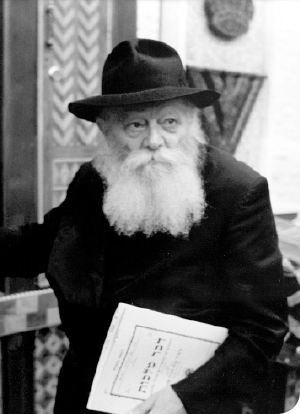From Chapter Six of Rabbi Shloma Majeski’s Likkutei Mekoros (Underlined text is the compiler’s emphasis.)
Translated by Boruch Merkur
 6. […] This concept is underscored by the birth of Moshe (on the seventh of Adar), as our Sages point out, “At the moment Moshe was born, the entire home was filled with light,” meaning that the birth of Moshe brought about light (the revelation of G-dliness) throughout the entire “home” (i.e., within natural, worldly experience).
6. […] This concept is underscored by the birth of Moshe (on the seventh of Adar), as our Sages point out, “At the moment Moshe was born, the entire home was filled with light,” meaning that the birth of Moshe brought about light (the revelation of G-dliness) throughout the entire “home” (i.e., within natural, worldly experience).
This idea is further emphasized in Moshe’s service of G-d, as well as the deeds he did throughout his lifespan (the potential for which was established on the day of his birth, on the seventh of Adar). That is, in assembling the Mishkan, Moshe brought about the primary and principle hamshacha (manifestation) and revelation of G-dliness in the world, as stated in the Midrash:
When Rosh Chodesh Nissan arrived and the Alm-ghty commanded the Jewish people to assemble the Mishkan (“the Jewish people were saying, ‘We have constructed the Mishkan, but when will the Sh’china come and rest amidst the work of our hands?’”), G-d sent Moshe to ask them: “Why do you worry? ‘I have (already) returned to the garden, my sister, my bride.’” Yishmoel, son of Rebbi Yossie said*: it does not say “gan – garden” but “gani,” meaning “g’nuni – the bridal chamber,” to the place where My essence was revealed in the beginning. And wasn’t the primary manifestation of the Sh’china in the physical realm? … When Adam sinned, the Sh’china departed to the first Firmament, etc.; the Egyptians sinned and the Sh’china ascended to the seventh Firmament. Corresponding to the seven who sinned, seven tzaddikim arose, and they drew down the Sh’china from the Supernal Realms to the Lower Realms … Avrohom drew It down from the seventh to the sixth, etc.; Moshe (who is the seventh, and “all sevens are beloved”), drew the Sh’china down from the Supernal Realm to the Lower Realms (i.e., Moshe rose and brought the Sh’china down to the earth).
Moreover, the erection of the Mishkan (during Shivas Yemei HaMiluim, the Seven Days of Initiation, when Moshe assembled and dismantled the Mishkan) began on the final seven days (“all goes according to the finale, the conclusion”) of the Month of Adar (from the twenty-third of Adar until the last day of the month of Adar).
Now, the beginning of the month of Adar underscores the might (“adir”) of the Alef (the head and first letter of the word “Adar”), which transcends the world (“Adir ba’marom Hashem – G-d is mighty On High”), whereas the remainder of the month (primarily the seventh of the month, when Moshe was born), and how much more so towards the end of the month (in the final week, when Moshe began erecting the Mishkan) emphasizes (the intent and purpose of) the hamshacha and revelation of G-dliness in the world (Adar, Alef – Dar, the continuation and end of the word “Adar”) brought about by the Mishkan.
Nevertheless, at the end of the month of Adar – when the assembling of the Mishkan had begun and “Moshe erected the Mishkan, served in it, and dismantled it each day” (throughout the Shivas Yemei HaMiluim) – the Sh’china did not rest within it.” There still was not the manifestation and revelation of G-dliness within the physical world; the G-dly manifestation and revelation still transcended the world, in a manner of “Adir ba’marom Hashem – G-d is mighty On High.”
The main hamshacha and revelation in the physical world from assembling the Mishkan – in a permanent manner and with the presence of the Sh’china – took place on Rosh Chodesh Nissan (yom ha’shmini la’miluim, the eighth day of initiating the Mishkan), and it was drawn down through the inauguration of the Mishkan by the N’siim of the Jewish people throughout the twelve days from Rosh Chodesh Nissan until the twelfth of Nissan (“one Nasi each day”). This stage further emphasizes the hamshacha and revelation of G-dliness within the framework of earthly experience, the twelve permutation of the Divine name Havaya (meaning “Mehoveh,” Creator), which give rise to and establish the concept of time (e.g., the twelve months of the year), as well as the creation of space, the Yud-Beis G’vulei Alchson. That is, a dimension of G-dliness that transcends the world is drawn down and revealed even within the framework of earthly experience (twelve). This unique manifestation of G-dliness comprises the significance of the month of Nissan, which derives from the word “neis – miracle,” including “nissei nissim.”
NOTES:
*And in Shir HaShirim Rabba 5:1: “Rebbi Menachem the son in-law of Rebbi Elazar son of Avuna said in the name of Rebbi Shimon son of Yosana” – this alludes to the ultimate expression of the resting of the Sh’china within the physical world brought about by “(the first redeemer is) the final redeemer” – “Menachem is his name” (Sanhedrin 98b).
(Tuesday, Friday, and Shabbos Kodesh of Parshas Tetzaveh, 7, 10, and 11 Adar Rishon 5751; Seifer HaSichos 5751, pg. 400-401)